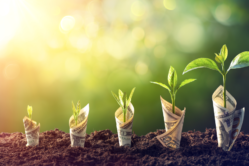The Thrift Savings Plan is a low-cost investment platform for military members and civil service employees. Thrift Savings Plan participants can invest in any of five diversified index funds or several target date retirement funds that automatically adjust their allocation based on the participant’s projected retirement date.
Available TSP investments include:
- C Fund – Large Cap U.S. stocks based on the S&P 500 index.
- S Fund – Small Cap U.S. stocks based on the Dow Jones U.S. Completion Total Stock Market Index.
- I Fund – International stock investment fund based on the MSCI EAFE (Europe, Australasia, Far East) Index.
- G Fund – Government Securities Investment Fund, a special class of government bonds.
- F Fund – Government and Corporate bond fund based on the Bloomberg U.S. Aggregate Bond Index
- L-Fund – LifeCycle Funds, or target date retirement funds, automatically allocate the previous five funds based on the participant’s projected retirement date.
These five core TSP investments enable investors to create a simple and diversified investment portfolio. The simplicity of the TSP is both one of its major benefits and one of the things people complain about most.
In 2022, the TSP created the TSP Mutual Fund Window. This enables participants to invest some of their portfolios in almost 5,000 outside mutual funds, giving them a greater variety of investments from which to choose. However, the opportunity comes with more risk and additional fees.
Here’s what you need to know.
Table of Contents
What is a Mutual Fund?
Mutual funds are pools of investor money put toward other investments, including stocks, bonds, and other securities. Investors purchase shares directly from mutual funds instead of from other investors in a larger market.
There are tens of thousands of mutual funds on the market. Some mutual funds may track a broad market index, such as the S&P 500 or a total stock market fund that tracks all stocks in a particular country or region. Other mutual funds may track a sector or industry. Some mutual funds may give investors more control over the companies, causes, and issues they want to direct their money toward, like environmental, social, and governance (ESG) funds.
Responsible and sustainable investing is on the rise. In a 2021 investor survey, Callan, an institutional investment firm, found that a record 70% of respondents were either already incorporating ESG funds in their investment decisions or considering it.
The downside to investing in mutual funds compared to investing in the core TSP funds is the associated cost. Many mutual funds, particularly those that are managed funds as opposed to passive funds, have significantly higher costs compared to TSP funds.
How Much Do TSP Mutual Funds Cost?
By law, TSP participants using the mutual fund window must pay fees that don’t apply to core fund investors.
These include:
- $95 annual maintenance fee
- $28.75 per trade
- $55 annual fee to cover administrative expenses so that traditional index fund investors don’t have to pay for an option they don’t use. The Board has proposed adjusting this fee every three years to keep up with the service cost.
- Any fees and expenses specific to individual mutual funds
This is inordinately expensive, according to The Military Wallet columnist and Certified Financial Planner Daniel Kopp.
“I’m thinking of a junior officer or enlisted service member with only $40,000 in the TSP. For the regular TSP expenses, they are paying less than $20 per year fees,” Kopp said.
Assuming 12 monthly mutual fund transactions, it would cost the investor, in his example, around $565 per year to participate in the new option – more than 30 times the price for index fund investing.
“The only scenario where I could see this making sense is for someone who has a major TSP balance of, say, $500,000 or more with little to no assets in an IRA and wants to add some specific investments,” Kopp said.
“Even then, I would just recommend they get access to those factors with an IRA through a custodian like Vanguard, Fidelity, or Schwab. Those custodians don’t have any trading fees for ETFs and have thousands of mutual funds without transaction fees.”
TSP Mutual Fund Requirements
The Federal Retirement Thrift Investment Board has proposed restrictions to minimize investor risk.
- TSP investors must have at least $40,000 in their accounts.
- The minimum initial transfer for the mutual fund window is $10,000.
- Mutual fund transfers can’t exceed 25% of an investor’s TSP index fund balance.
Mutual fund transfers will also count toward the TSP’s maximum interfund transfer limit of two per calendar month (excluding the G fund).
How the TSP Mutual Fund Window Works
Under the proposed rule, TSP investors must create a mutual fund window account and sign an acknowledgment of risk.
Once done, you can transfer funds from your TSP balance to a sweep account. Sweep accounts are high-interest money market funds that hold your money until you choose your mutual funds.
You can’t direct automatic contributions to mutual funds or withdraw money from them. Your money has to be in an index fund first. (Remember: transfers back and forth can incur fees).
If you’re receiving payments from a TSP under court or IRS order, your index fund accounts must have enough money in them to cover it.
If the funds are insufficient, the Board will make an automatic “forced transfer” from your sweep account or mutual fund investments back to the index funds in your contribution allocation. If you’ve got less than $25,000 in mutual funds, the Board will forcibly transfer the entire balance.
Should You Use the TSP Mutual Fund Window?
The TSP offers five simple funds that provide enough diversification for most investment needs. This article discusses why the TSP offers enough diversification for investors.
In short, the TSP enables participants to invest in thousands of companies (C, S, and I Funds) and get bond exposure through guaranteed government bonds (G Fund) and a blend of government and corporate bonds (F Fund). And, of course, participants can use the LifeCycle funds to have a mixture of all of the above funds in one convenient package that automatically adjusts for risk as they near retirement age.
Investors who want more control over their investments can look at other investment opportunities. While they can do so through the Mutual Fund Window, the costs are fairly significant. It would be easier and cheaper for participants to invest in external funds through an IRA or a taxable investment account.
Here are resources that may be helpful:
Who Should Use the TSP Mutual Fund Window?
While there are fairly large costs associated with the TSP Mutual Fund Window, it may make sense for some investors. The best situation is for someone with a fairly large TSP account who will make a minimal number of mutual fund transfers or purchases. This enables them to minimize the costs associated with buying outside mutual funds.
A fairly large TSP account is required to make this worthwhile. The rules require a participant to have at least $40,000 in their TSP account, they must make at least an initial $10,000 transfer to the Mutual Fund Window, and they can allocate no more than 25% of their account toward outside mutual funds.
However, the annual maintenance fee and administrative fees are rather high for what would amount to a $10,000 mutual fund investment.
Participants would do better to wait until they have a larger account balance so the associated fees make up a smaller percentage of their total investment. Otherwise, they are better off obtaining those investments through outside accounts (e.g. an IRA or a taxable brokerage account).
It will also be important to minimize fees by limiting the number of purchases made each year. One way to accomplish this is to make an initial one-time transfer to the Mutual Fund Window and reallocate their account once a year or as needed.
TSP Mutual Fund Manager Will Modernize Platform
The TSP’s new mutual fund window has been about 13 years in the making.
In 2009, Congress authorized (but didn’t require) the Federal Retirement Thrift Investment Board to offer the option to TSP participants after a survey indicated investors’ interest.
The Employee Thrift Advisory Council and the Board – which runs the Thrift Savings Plan – at first disagreed on creating the program. In 2014, the Board presented the results of several years of study, and the mutual fund window received unanimous approval the next year.
In 2019, recordkeeping service proposals started rolling in. The Board awarded the contract to Accenture Federal Services in 2020.
“It’s an honor to support the FRTIB to reimagine retirement services and improve the customer experience of the TSP,” Elaine Beeman wrote in November 2020.
Beeman is the civilian lead and senior managing director for Accenture Federal Services. She said Accenture will not only implement the mutual fund option but also create a more modern platform for TSP investors.
TSP Mobile App and More Ahead
Accenture aims to streamline routine TSP processes and reduce paperwork by introducing digital signatures, mobile check deposits for TSP rollovers, and a secure digital mailbox.
Customer service expansions include 24-hour automated virtual assistance and a dedicated live chat “ThriftLine.” Users can also call ThriftLine’s hotline for phone assistance.
The TSP mobile app, slated for launch in mid-2022, will allow users to manage their TSP and communicate with virtual assistants. The app will feature easy log-in options tailored to your smartphone’s built-in software, like fingerprint access and facial recognition.
“The new functions will give participants more self-service options to meet the expectations of an increasingly digital, savvy TSP customer,” Beeman said.




About the comments on this site:
These responses are not provided or commissioned by the bank advertiser. Responses have not been reviewed, approved or otherwise endorsed by the bank advertiser. It is not the bank advertiser’s responsibility to ensure all posts and/or questions are answered.